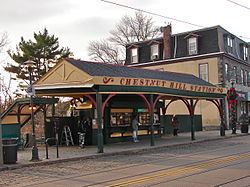Zip code 19118 | Area code Area codes 215 and 267 | |
 | ||
Restaurants Tavern On the Hill, CinCin, El Poquito, Cake, Paris Bistro & Jazz Cafe | ||
Germantown ave in chestnut hill philadelphia pa
Chestnut Hill is a neighborhood in the Northwest Philadelphia section of the United States city of Philadelphia, Pennsylvania. It is known for its high incomes and real estate values, as well as its private schools.
Contents
- Germantown ave in chestnut hill philadelphia pa
- Map of Chestnut Hill Philadelphia PA USA
- Boundaries
- ZIP code
- History
- Architecture and housing stock
- Public transportation
- Regional rail commuter rail
- Buses
- Trolleys trams
- Colleges and universities
- Public education
- Private education
- Public libraries
- Parks and arboretums
- Other notable civic institutions
- Notable people
- References
Map of Chestnut Hill, Philadelphia, PA, USA
Boundaries
Chestnut Hill is bounded as follows:
ZIP code
The USPS does not officially correlate neighborhood names to Philadelphia ZIP codes (all are called simply "Philadelphia" or "Phila"). However, the 19118 ZIP code is almost entirely coterminous with the cultural-consensus boundaries of Chestnut Hill.
History
The village of Chestnut Hill was part of the German Township laid out by Francis Daniel Pastorius and came to include the settlements originally known as Sommerhausen and Crefeld, as well as part of Cresheim. It served as a gateway between Philadelphia and the nearby farmlands. During the American Revolutionary War era (late 18th century), the area was one of many summer vacation spots due to its higher elevation, 400–500 feet (120 to 150 m) above sea level, and cooler temperatures than the historic Center City. Chestnut Hill is still stereotypically known as one of the more affluent sections of Philadelphia. However, there are many residents who fall within lower/middle class incomes.
Chestnut Hill (along with many other towns and farmlands of Philadelphia County) became part of the City of Philadelphia in 1854 as part of the Act of Consolidation, when the County and the City became completely coterminous. In the same year, the Chestnut Hill Railroad opened, making an easy commute to and from Center City.
During the American Civil War, Chestnut Hill was home to Mower U.S. Army General Hospital, constructed to serve Union army soldiers.
From the mid-19th century through the mid-20th, the neighborhood served as both a "railroad suburb" and a "streetcar suburb" of Center City; although it was part of Philadelphia, it was a leafy outlying part functioning as a bedroom community. (It still serves this function, although the streetcars are gone.) The neighborhood contains a wide variety of 19th and early 20th century residential buildings by many of the most prominent Philadelphia architects.
Architecture and housing stock
In 2011, Chestnut Hill had a median home sale price of $629,500—the highest of any Philadelphia neighborhood outside of Center City. This price was an increase of 57% from its 2005 median price.
The Chestnut Hill listings on the National Register of Historic Places:
Other historic and notable properties include:
Public transportation
Public transportation in southeastern Pennsylvania, which includes Philadelphia and the surrounding counties, is provided by SEPTA, the region's mass transit authority.
Regional rail (commuter rail)
Two SEPTA Regional Rail lines serve Chestnut Hill: the Chestnut Hill East Line and Chestnut Hill West Line.
Buses
Chestnut Hill is served by SEPTA bus routes from both the City Transit Division (23, 77 and L) and the Suburban Division (94 and 97).
Trolleys (trams)
Trams in the southeastern Pennsylvania region are known as trolleys. The trolley network of this region was very extensive prior to World War II, but has shrunk since that era. Chestnut Hill was formerly served by trolleys. Trolley service to Chestnut Hill began in 1894, and trolley tracks still run down the Belgian-block-paved main street of the neighborhood, Germantown Avenue, which was served by SEPTA Route 23. SEPTA "temporarily suspended" regular trolley service in 1992. From 1992 until 1996, weekend-only service ran between Chestnut Hill and Mount Airy, re-branded The "Chestnut Hill Trolley." Sporadic trolley charter trips ran down Germantown Avenue and into North Philadelphia until 2003. In 2010, the Pennsylvania Department of Transportation completed work on restoring segments of the trolley infrastructure and streetscape in Chestnut Hill, Mount Airy and Germantown. As of 2011, SEPTA spokespeople publicly state that there are no plans to reinstate trolley service on Route 23, despite claims to the contrary in their annual capital budget reports.
The dismantling of Route 23 infrastructure is unpopular with a large segment of local residents. This topic generates heated emotions because it is related to the larger issue of the Great American streetcar scandal. Further discussion of the arguments and counterarguments is beyond the scope of this article.
Colleges and universities
Public education
Residents are zoned to schools in the School District of Philadelphia. Students in grades kindergarten through 8 are zoned to John Story Jenks School, while students in grades 9 through 12 are zoned to Roxborough High School. Students were previously zoned to Germantown High School.
Private education
Chestnut Hill is home to several private schools. Perhaps the best-known are the K-12 Chestnut Hill Academy (boys) and Springside School (girls), since 2010 merged as the semi-coeducational Springside Chestnut Hill Academy. The other three private schools in Chestnut Hill are The Crefeld School (7-12), and the K-8 Norwood-Fontbonne Academy and Our Mother of Consolation.
Many "Chestnut Hillers" also send their children to private schools in nearby neighborhoods such as William Penn Charter School, Germantown Friends School, Germantown Academy, Saint Joseph's Preparatory School, Abington Friends School, LaSalle College High School, Mount Saint Joseph Academy. and The Center School (Abington, Pennsylvania)
Public libraries
Free Library of Philadelphia operates the Chestnut Hill Branch at 8711 Germantown Avenue.
